The lemma surface texture of these two taxa can't really be distinguished at 20X, but as shown below,
45X reveals a distinction, made exceptionally clear by SEM scans.
The lemma surface texture of these two taxa can't really be distinguished at 20X, but as shown below,
45X reveals a distinction, made exceptionally clear by SEM scans.

The so-called Sporobolus compositus complex consists of 3 varieties of S. compositus (earlier S. asper) — S. c. var. compositus, S. c. var. drummondii, S. c. var. macer — and S. clandestinus (also sometimes treated as a variety of S. compositus).
Keys use lemma vestiture as a differentia, somewhat simplified as:
C. G. Reeder (in Gould 1975, The Grasses of Texas, p. 289):
Diggs et al. 2006 (Illustrated Flora of East Texas Vol. 1, p. 1071):
Peterson et al. 2003 (Flora of North America (hence FNA), Vol. 25, pp. 116-117) treat the complex in two sections of their key:
A more serious problem prior to Peterson et al. is the use of pubescence as the sole vestiture differentia for S. clandestinus.
The larger images below are all of a 1 mm selection with a dissecting scope at 45X. Although the camera did not provide a clear image of the fine details that are visible to the eye, I feel that it was sufficient to illustrate the details at issue. An attempt was made to compensate for limited depth of field by manually photoshopping a series of images taken with focus on different areas of the lemma. (Focus-stack software proved incapable of doing this.) Other images are from SEM scans relevant to the interpretation of the scope images. The SEM lemma scans, provided by John Mendenhall, show several types of cells as well as macrohairs (for S. clandestinus & S. vaginiflorus): (1) long cells (the typical epidermis), (2) prickles, (3) silica cells, (4) microhairs (generally lacking their upper cell), and (5) hooks (unique to S. vaginiflorus).
The two images are from the same lemma, on the left from just below the tip and on the right ca. 1 mm above the base. The surface of the lemma was densely populated with prickles (directed toward the tip, leftward). A few hairs are visible, one clearly shown at the top of the second image. The parallel lines are the edges of long cells.
SEM scans showing the prickles on the lemma surface near the tip. Also visible in the wider scan are silica cells (flat roundish objects) and microhair cell bases (jug shaped, with the top cell missing).
Two images are from the same lemma, on the left from just below the tip and on the right ca. 1 mm above the base. At 45X the lemma surface appears smooth, covered with long cells, prickles occurring only along the mid vein (barely discernable on the bottom edge of the tip image) and its immediate vicinity. The white dots are primarily silica cells, often one per long cell.
SEM scans of the lemma surface near the tip showing the long cells with round–oblong silica cells and the prickles on the mid vein. Also visible are a few prickles and microhair cell bases ("gaping", with the top cell missing).
The lemma of var. macer is similar to that of var. compositus, with prickles more clearly discernable at the mid vein (top). Other cells present are less apparent, especially the abundant silica cells.
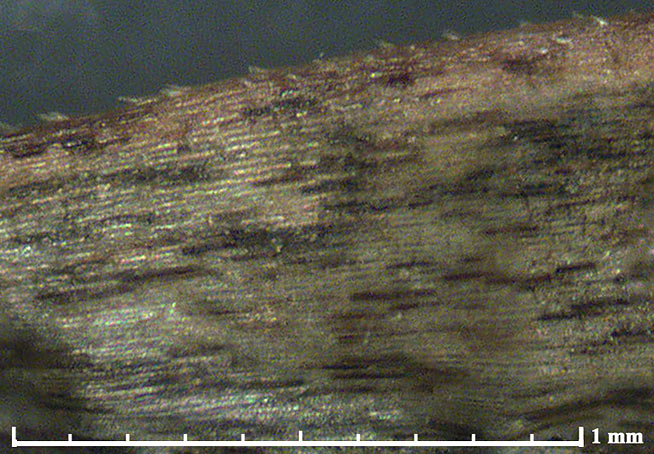
SEM scan of the lemma surface near the tip showing the long cells with round–oblong silica cells (dark but clearly visible). Also visible are a few prickles and a microhair cell base (jug shaped, with the top cell missing).
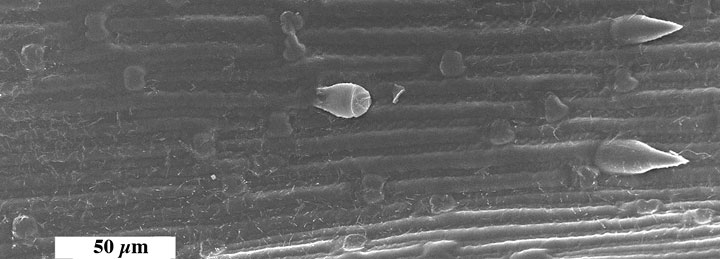
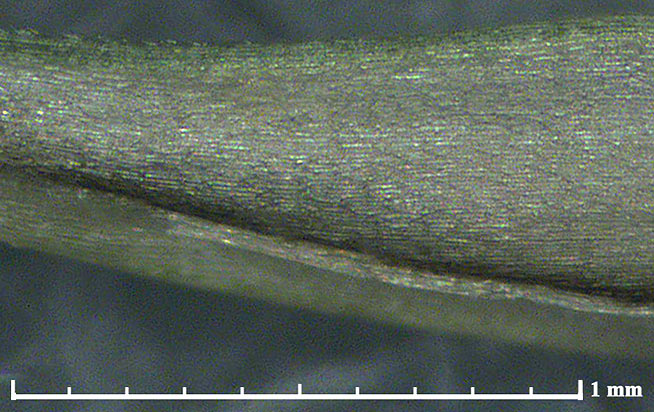
SEM scan of the lemma surface near the tip with the mid vein along the bottom with prickles. The long cells on the surface are associated with roundish silica cells. Out of focus image on the right shows 2 microhair cell bases (tubular, narrowing toward the base).
The Sporobolus vaginiflorus Complex consists of the annuals S. vaginiflorus, S. ozarkanus, and S. neglectus, the latter two at various times treated as varieties of S. vaginiflorus. In her 1969 thesis, "The annual cleistogamous species of Sporobolus," R. Riggins presents a detailed and compelling case for these three taxa. This was apparently accepted by C. G. Reeder, who wrote the Sporobolus article in Gould 1975.* In contrast with the recent FNA treatment these both recognize the glabrous lemmas of S. ozarkanus, contrasting those forms of S. ozarkanus having glabrous lemmas(not attested in Texas) with S. neglectus; and those with pubescent lemmas with S. vaginiflorus (note the map below). The FNA treatment appears to assign all non-strigose lemma forms to S. neglectus, but does not address this issue. The FNA follows the prevailing view that S. vaginiflorus has two varieties, one being S. vaginiflorus var. ozarkanus (Fernald) Shinners S. ozarkanus.**
*Although Reeder's key is slightly different, she uses floret length/width ratio measurements identical to those in Riggins 1969.In examining the TEX/LL Texas collections in 2002 I noted that Riggins had not determined any collections to be S. ozarkanus and concluded (incorrectly) that she no longer distinguished S. vaginiflorus and S. ozarkanus, since Hatch and McGregor had identified many of these collections as S. ozarkanus. At the time I concluded that there was no clear basis for distinguishing these taxa (in effect agreeing with Riggins). I have only recently seen Riggins 1969, and have learned that she distinguished these two taxa, but did not consider the Texas plants to be S. ozarkanus. Here are her maps for the distribution of S. ozarkanus and S. vaginiflorus:
**This variety, based on Fernald, must include the forms with glabrous florets of Fernald's type specimens, E.J. Palmer 3133 & 3133A [GH].
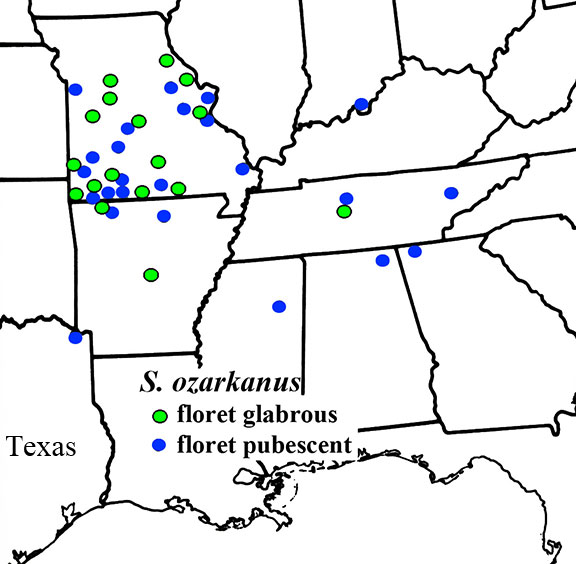 |
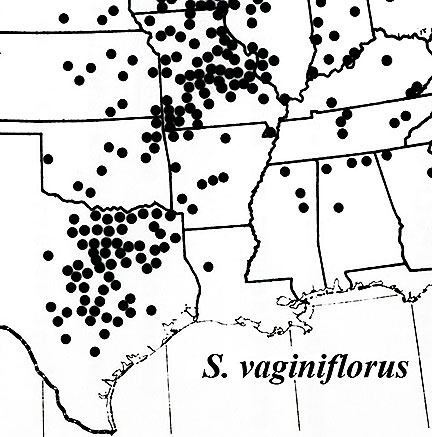 |
|---|
Although Riggins examined many Texas collections, S. ozarkanus was identified only from Bowie County in the extreme NE corner of the state. Equally interesting is the abundant representation of both taxa in Missouri, where they are sympatric.
The lemma vestiture of S. vaginiflorus and S. ozarkanus is unique and unmistakable. I find it inconceivable that anyone with access to a good dissecting microscope (available in all herbaria) could confuse these taxa with any other Sporobolus taxon. Even at 45X one can see that the long cell patterns seen above are only barely visible and that the surface is covered with some sort of texture — all those dots. With good scope lighting these appear as minute papillae. They are hooks.
SEM scans show the directional 'hook' pointed top of these cells which densely populate the lemma surface — a feature not shared by any other Sporobolus taxon. Also present are hairs, a few microhair bases, dumbbell-shaped silica cells. One can just make out the edges of the long cells.
At 45X the lemma appears very glabrous, almost shiny, with long cells readily apparent. The white dots seen below are microhair bases, which are somewhat more dense that with the other taxa.
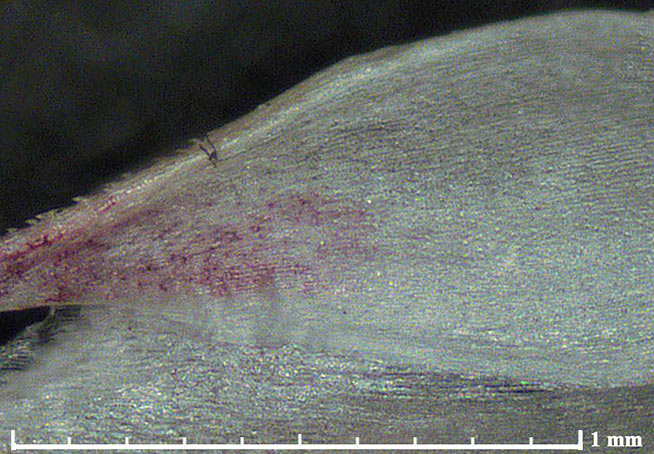
The SEM scans show the long cells with sinuate margins, microhair bases, silica cells and two prickles.